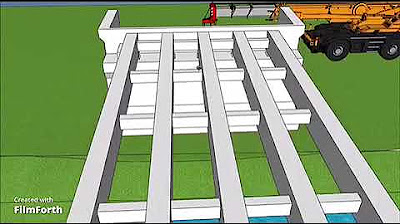Piling Activity Example, Applicability of different methods to Estimate Activity Duration
Summary
TLDRThe video script discusses the complexities of piling activity for bridge construction, emphasizing the impact of soil conditions on productivity. It explores parametric estimating, using winch productivity rates for soft soil and soft rock to calculate the duration of piling work. The script also highlights the challenges of estimating activity duration and the importance of considering uncertainties in project planning. It concludes by comparing different estimating techniques, including expert judgment and three-point estimates, and underscores the significance of accurate duration estimation for effective project management.
Takeaways
- 🏗️ The script discusses a construction scenario involving piling activities for a bridge with varying soil conditions on each side.
- 🔍 It highlights the impact of soil conditions—soft soil and soft rock—on production and productivity in piling operations.
- 📏 The script specifies the quantity of work, with 20 piles per abutment and each pile being 15 meters long.
- ⏱️ Productivity rates are given as 1.5 meters per hour for soft soil, implying different rates for soft rock, though not explicitly stated.
- 👷♂️ The process involves a winch-operated system for piling, where soil is removed and piles are poured into the ground.
- 🕒 The script emphasizes the importance of understanding the duration of work, which is initially calculated as 10 hours per day.
- 🔢 A calculation error is pointed out regarding the conversion of meters per hour to days, leading to a corrected estimate of 20 days for soft soil.
- 📉 The script suggests adjusting working hours to balance the duration of work between the two different soil conditions.
- 🛠️ It introduces the concept of parametric estimating, which uses factors like productivity and quantity to estimate project duration.
- 🤔 The challenges of estimating duration are discussed, including uncertainties due to variations and lack of concrete data.
- 📚 The script also touches on other estimating techniques such as expert judgment, analogous estimating, and three-point estimating, emphasizing their practicality and limitations.
Q & A
What is the main topic discussed in the script?
-The main topic discussed in the script is the process of estimating the duration of piling activities for a bridge construction project, taking into account different factors such as soil conditions and productivity rates.
What are the two different soil conditions mentioned in the script?
-The two different soil conditions mentioned are soft soil and soft rock.
How many piles per abutment are mentioned in the script for the bridge piling activity?
-The script mentions that there are 20 piles per abutment for the bridge piling activity.
What is the length of each pile mentioned in the script?
-The length of each pile mentioned in the script is 15 meters.
What is the normal productivity of a winch-operated system in soft soil as per the script?
-The normal productivity of a winch-operated system in soft soil is stated to be 1.5 meters per hour.
What does the script suggest about adjusting the number of working hours based on different soil conditions?
-The script suggests that one might decrease the number of working hours for soft soil and increase it for soft rock to balance the durations of piling activities on both sides of the bridge.
What is the concept of 'parametric estimating' as discussed in the script?
-Parametric estimating, as discussed in the script, is a method of estimating project duration or cost by using a statistical relationship between historical data and other variables such as quantity or productivity.
What are some of the challenges mentioned in the script regarding parametric estimating?
-Some challenges mentioned in the script regarding parametric estimating include uncertainties in productivity and the difficulty in obtaining accurate data for the estimates, which can lead to disruptions in project schedules.
What are the other duration estimating techniques briefly mentioned in the script?
-The other duration estimating techniques briefly mentioned in the script are expert judgment, analogous estimating, three-point estimate, and reserve analysis.
Why might expert judgment be used instead of parametric estimating in some cases?
-Expert judgment might be used instead of parametric estimating when there is a lack of historical data or when the effort to make a detailed parametric estimate is more than the value it provides, making it a more practical and efficient approach.
What does the script imply about the importance of accurate duration estimating in project management?
-The script implies that accurate duration estimating is crucial in project management as it drives the planning process and can significantly impact the project schedule and resource allocation.
Outlines

Cette section est réservée aux utilisateurs payants. Améliorez votre compte pour accéder à cette section.
Améliorer maintenantMindmap

Cette section est réservée aux utilisateurs payants. Améliorez votre compte pour accéder à cette section.
Améliorer maintenantKeywords

Cette section est réservée aux utilisateurs payants. Améliorez votre compte pour accéder à cette section.
Améliorer maintenantHighlights

Cette section est réservée aux utilisateurs payants. Améliorez votre compte pour accéder à cette section.
Améliorer maintenantTranscripts

Cette section est réservée aux utilisateurs payants. Améliorez votre compte pour accéder à cette section.
Améliorer maintenantVoir Plus de Vidéos Connexes

Animasi Jembatan Ngarai Sianok Bukittinggi

Ponte de Palito de Picolé - Parte 1 - UNIVAG 2021 - Lucas Kenzo - Luiz Gabriel. - Projeto Unificado

Animasi Pembuatan Jembatan Beton Bertulang Prodi Teknik Sipil F. Teknik Um Sumbar

How to Grow Amazing Plants with Compost Tea - Masterclass with Dr. Elaine Ingham (Part 1 of 5)

Pengertian Kesuburan Tanah (Materi Kesuburan Tanah Dan Pemupukan)

Why Bridges Don't Sink
5.0 / 5 (0 votes)
